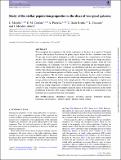Files in this item
Study of the stellar population properties in the discs of ten spiral galaxies
Item metadata
| dc.contributor.author | Morelli, L. | |
| dc.contributor.author | Corsini, E.M. | |
| dc.contributor.author | Pizzella, A. | |
| dc.contributor.author | Dalla Bontà, E. | |
| dc.contributor.author | Coccato, L. | |
| dc.contributor.author | Mendez Abreu, Jairo | |
| dc.date.accessioned | 2015-10-08T14:10:05Z | |
| dc.date.available | 2015-10-08T14:10:05Z | |
| dc.date.issued | 2015-09-11 | |
| dc.identifier | 222360378 | |
| dc.identifier | 43848cfe-5ffa-4ffc-974a-adca385c215e | |
| dc.identifier | 84940116929 | |
| dc.identifier | 000360851900004 | |
| dc.identifier.citation | Morelli , L , Corsini , E M , Pizzella , A , Dalla Bontà , E , Coccato , L & Mendez Abreu , J 2015 , ' Study of the stellar population properties in the discs of ten spiral galaxies ' , Monthly Notices of the Royal Astronomical Society , vol. 452 , no. 2 , pp. 1128-1139 . https://doi.org/10.1093/mnras/stv1357 | en |
| dc.identifier.issn | 0035-8711 | |
| dc.identifier.uri | https://hdl.handle.net/10023/7633 | |
| dc.description | This work was supported by Padua University through grants 60A02-4807/12, 60A02-5857/13, 60A02-5833/14, and CPDA133 894. LM acknowledges financial support from Padua University grant CPS0204. JMA acknowledges support from the European Research Council Starting Grant (SEDmorph, P.I. V. Wild) | en |
| dc.description.abstract | We investigated the properties of the stellar populations in the discs of a sample of 10 spiral galaxies. Our analysis focused on the galaxy region where the disc contributes more than 95 per cent of total surface brightness in order to minimize the contamination of the bulge and bar. The luminosity-weighted age and metallicity were obtained by fitting the galaxy spectra with a linear combination of stellar population synthesis models, while the total overabundance of α-elements over iron was derived by measuring the line-strength indices. Most of the sample discs display a bimodal age distribution and they are characterized by a total [α/Fe] enhancement ranging from solar and supersolar.We interpreted the age bimodality as due to the simultaneous presence of both a young (Age≤4 Gyr) and an old (Age>4 Gyr) stellar population. The old stellar component usually dominates the disc surface brightness and its light contribution is almost constant within the observed radial range. For this reason, no age gradient is observed in half of the sample galaxies. The old component is slightly more metal poor than the young one. The metallicity gradient is negative and slightly positive in the old and young components, respectively. These results are in agreement with an inside-out scenario of disc formation and suggest a reduced impact of the radial migration on the stellar populations of the disc. The young component could be the result of a second burst of star formation in gas captured from the environment. | |
| dc.format.extent | 12 | |
| dc.format.extent | 1287098 | |
| dc.language.iso | eng | |
| dc.relation.ispartof | Monthly Notices of the Royal Astronomical Society | en |
| dc.subject | Galaxies: abundances | en |
| dc.subject | Galaxies: evolution | en |
| dc.subject | Galaxies: formation | en |
| dc.subject | Galaxies: kinematics and dynamics | en |
| dc.subject | Galaxies: spiral | en |
| dc.subject | Galaxies: stellar content | en |
| dc.subject | QB Astronomy | en |
| dc.subject | QC Physics | en |
| dc.subject | NDAS | en |
| dc.subject.lcc | QB | en |
| dc.subject.lcc | QC | en |
| dc.title | Study of the stellar population properties in the discs of ten spiral galaxies | en |
| dc.type | Journal article | en |
| dc.contributor.sponsor | European Research Council | en |
| dc.contributor.institution | University of St Andrews. School of Physics and Astronomy | en |
| dc.identifier.doi | 10.1093/mnras/stv1357 | |
| dc.description.status | Peer reviewed | en |
| dc.identifier.grantnumber | ERC-2012-StG-20111012 | en |
This item appears in the following Collection(s)
Items in the St Andrews Research Repository are protected by copyright, with all rights reserved, unless otherwise indicated.

